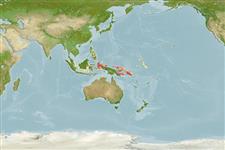>
Eupercaria/misc (Various families in series Eupercaria) >
Lutjanidae (Snappers) > Lutjaninae
Etymology: Lutjanus: Malay, ikan lutjan, name of a fish; papuensis: Named for its type locality, West Papua.
Environment: milieu / climate zone / depth range / distribution range
Écologie
marin récifal; profondeur 6 - 15 m (Ref. 93093). Tropical
Western Pacific: Indonesia, Papua New Guinea, the Solomon Islands; observed at Timor Leste.
Taille / Poids / Âge
Maturity: Lm ? range ? - ? cm
Max length : 25.9 cm SL mâle / non sexé; (Ref. 93093)
Description synthétique
Clés d'identification | Morphologie | Morphométrie
Épines dorsales (Total) : 10; Rayons mous dorsaux (Total) : 13; Épines anales: 3; Rayons mous anaux: 8. This species is distinguished by the following set of characters: D X,13; total gill rakers 16; body depth 2.4-2.8 in SL; eye 4.5-4.7 in HL; interorbital 5.5-6.5 in HL; the scale rows above the lateral line rising obliquely toward dorsal profile; predorsal scales extends slightly anterior to level of preopercular margin; weakly developed preopercular notch and interopercular knob; upper surface of tongue with central patch of fine granular teeth; vomer with narrow, crescent-shaped patch of granular teeth, no medial posterior extension; slightly emarginate caudal fin; in life it is reddish to yellow on head, bluish to grey on upper side, grading to yellow-orange below lateral line; bright yellow anal and pelvic fins, presence of a black spot at base of uppermost pectoral-fin rays (Ref. 93093).
Found in fringing reefs and generally observed solitarily or in small groups (Ref. 93093).
Life cycle and mating behavior
Maturité | Reproduction | Frai | Œufs | Fécondité | Larves
Allen, G.R., W.T. White and M.V. Erdmann, 2013. Two new species of snappers (Pisces: Lutjanidae: Lutjanus) from the Indo-West Pacific. J. Ocean Sci. Found. 6:33-51. (Ref. 93093)
Statut dans la liste rouge de l'IUCN (Ref. 130435: Version 2024-2)
Menace pour l'homme
Harmless
Utilisations par l'homme
Outils
Articles particuliers
Télécharger en XML
Sources Internet
Estimates based on models
Preferred temperature (Ref.
123201): 28.7 - 29.3, mean 28.9 °C (based on 272 cells).
Phylogenetic diversity index (Ref.
82804): PD
50 = 0.5000 [Uniqueness, from 0.5 = low to 2.0 = high].
Bayesian length-weight: a=0.01479 (0.00706 - 0.03101), b=2.97 (2.80 - 3.14), in cm total length, based on LWR estimates for this Genus-body shape (Ref.
93245).
Niveau trophique (Ref.
69278): 3.8 ±0.7 se; based on size and trophs of closest relatives
Résilience (Ref.
120179): Milieu, temps minimum de doublement de population : 1,4 à 4,4 années (Preliminary K or Fecundity.).
Fishing Vulnerability (Ref.
59153): Low vulnerability (22 of 100).
